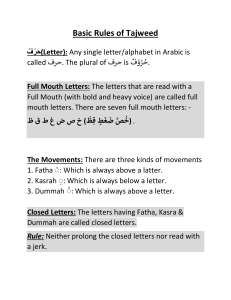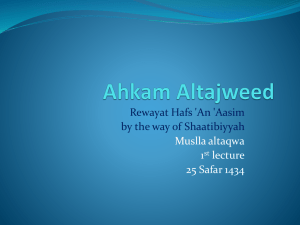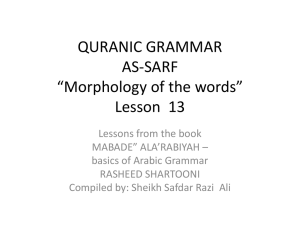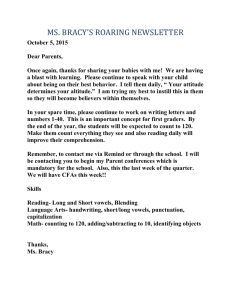Quranic Studies and Arabic Language
advertisement
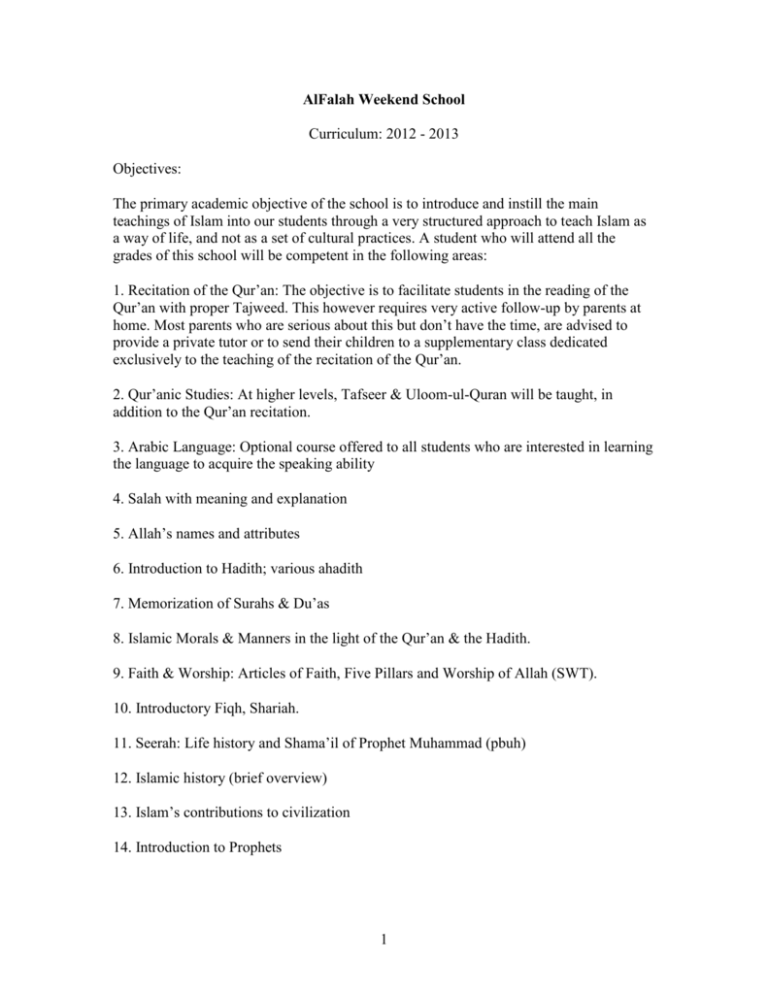
AlFalah Weekend School Curriculum: 2012 - 2013 Objectives: The primary academic objective of the school is to introduce and instill the main teachings of Islam into our students through a very structured approach to teach Islam as a way of life, and not as a set of cultural practices. A student who will attend all the grades of this school will be competent in the following areas: 1. Recitation of the Qur’an: The objective is to facilitate students in the reading of the Qur’an with proper Tajweed. This however requires very active follow-up by parents at home. Most parents who are serious about this but don’t have the time, are advised to provide a private tutor or to send their children to a supplementary class dedicated exclusively to the teaching of the recitation of the Qur’an. 2. Qur’anic Studies: At higher levels, Tafseer & Uloom-ul-Quran will be taught, in addition to the Qur’an recitation. 3. Arabic Language: Optional course offered to all students who are interested in learning the language to acquire the speaking ability 4. Salah with meaning and explanation 5. Allah’s names and attributes 6. Introduction to Hadith; various ahadith 7. Memorization of Surahs & Du’as 8. Islamic Morals & Manners in the light of the Qur’an & the Hadith. 9. Faith & Worship: Articles of Faith, Five Pillars and Worship of Allah (SWT). 10. Introductory Fiqh, Shariah. 11. Seerah: Life history and Shama’il of Prophet Muhammad (pbuh) 12. Islamic history (brief overview) 13. Islam’s contributions to civilization 14. Introduction to Prophets 1 Curriculum Specifics * The curriculum contains broad aspect of Islam based on the Qur’an and authentic Ahadith. The topics in the curriculum are laid out in a systematic manner to suit the teaching needs in a weekend Islamic school. Topics are selected based on age and learning levels of each class. Some topics are covered in multiple levels to add different perspective, details and additional emphasis. * The selected books do not simply disseminate knowledge, but make it relevant to the students’ life and their world. The lessons do not use a lecturing tone, but engage the students in a respectful discussion. * Many lessons require students to consult an English translation of the Qur’an. The idea is to develop a habit of using the Qur’an as a ready reference guide. * Though the Youth group uses the same structured approach as the rest of the school, it tends to be more discussion-oriented and deals with current events, frequently asked questions, meaning and comprehension of the Qur’an, ahadith, du’as, and topics of general interest to the older students. Weekend School Curriculum (2012 – 2013): Qur’anic Studies Step 1 Material: Beginners Arabic Reading - Weekend Learning Lesson 1: Introduction to the Arabic letters (Huroof) Lesson 2: Identification of letters Lesson 3: Mixed Letters a) Introduction to Hamza b) Differentiate the Sounds: Example Letters: Saawd, Seen, Tha (each letter has a distinct sound) Lesson 4: Short Vowel Fathah a) Reading Practice: Fathah b) Reading Practice: Fathah- Words made of 2 letters Lesson 5: Short Vowel Kasrah a) Reading Practice: Kasrah b) Reading Practice: Kasrah - Words made of 2 letters 2 Lesson 6: Short Vowel Dhammah a) Reading Practice: Dhammah b) Reading Practice: Dhammah- Words made of 2 letters Lesson 7: Practice with Vowels Lesson 8: Practice with Vowels Lesson 9: Tanweens- Two Fathah (Fathatain), TwoKasrah (Kasrahtain) , Two Dhammah (Dhammatain) a) Reading Practice Lesson 10: Practice with Tanweens a) Reading Practice: Combined Exercise Lesson 11: Practice with Joining Letters a) Shapes of letters with respect to their positions. b) Reading Practice: The shape of the letter depends on whether it is in the beginning, middle, or end of the word c) Reading Practice: Fathah - Words made of 3 letters d) Reading Practice: 2 Short Vowels (Fathah and Kasrah) in ONE WORD e) Reading Practice: 2 Short Vowels (Fathah and Dammah) in ONE WORD f) Reading Practice: 3 Short Vowels (Fathah, Kasrah, Dhmmah) in ONE WORD Lesson 12: Letters that don’t join a) Reading Practice: 6 Huroof (Alif, Daal, Zhaal, Raa, Zhaa, Waw) Which don’t join with a letter after it Lesson 13: Letters that don’t join a) Reading Practice: 6 Huroof (Alif, Daal, Zhaal, Raa, Zhaa, Waw) Which don’t join with a letter after it Weekend School Curriculum (2012– 2013): Qur’anic Studies Step 2 Material: Beginners Arabic reading - Weekend Learning Lesson 1: Introduction to the Arabic letters (Huroof) Lesson 2: Identification of letters 3 Lesson 3: Mixed Letters a) Introduction to Hamza b) Differentiate the Sounds: Example Letters: Saawd, Seen, Tha (each letter has a distinct sound) Lesson 4: Short Vowel Fathah a) Reading Practice: Fathah b) Reading Practice: Fathah- Words made of 2 letters Lesson 5: Short Vowel Kasrah a) Reading Practice: Kasrah b) Reading Practice: Kasrah - Words made of 2 letters Lesson 6: Short Vowel Dhammah a) Reading Practice: Dhammah b) Reading Practice: Dhammah - Words made of 2 letters Lesson 7: Practice with Vowels Lesson 8: Practice with Vowels Lesson 9: Tanweens - Two Fathah (Fathatain), Two Kasrah (Kasrahtain), Two Dhammah (Dhammatain) a) Reading Practice Lesson 10: Practice with Tanweens a) Reading Practice: Combined Exercise Lesson 11: Practice with Joining Letters a) Shapes of letters with respect to their positions b) Reading Practice: The shape of the letter depends on whether it is in the beginning, middle, or end of the word c) Reading Practice: Fathah - Words made of 3 letters d) Reading Practice: 2 Short Vowels (Fathah and Kasrah) in ONE WORD e) Reading Practice: 2 Short Vowels (Fathah and Dammah) in ONE WORD f) Reading Practice: 3 Short Vowels (Fathah, Kasrah, Dhmmah) in ONE WORD Lesson 12: Letters that don’t join a) Reading Practice: 6 Huroof (Alif, Daal, Zhaal, Raa, Zhaa, Waw) Which don’t join with a letter after it Lesson 13: Letters that don’t join a) Reading Practice: 6 Huroof (Alif, Daal, Zhaal, Raa, Zhaa, Waw) Which don’t join with a letter after it 4 Lesson 14: Sukoon a) Reading Practice: 2 Letters Word b) Reading Practice: 3 Letters Word c) Reading Practice: 4 Letters Word Lesson 15: Sukoon and Tanween a) Reading Practice: 3 Letters Word with Tanween and Sukoon Lesson 16: Maddah Letters (stretch 2 Haraka) a) Reading Practice: Introduction of Madd Letters (Alif Maddah, Yaa Maddah, Waw Maddah) Lesson 17: Part1: Alif Maddah (Alif, preceded by a letter with a Fathah) a) Reading Practice: Alif Maddah b) Reading Practice: Alif Maddah with Short Vowels and Tanween Part2: Yaa Maddah (Yaa Saakinah, preceded by a letter with Kasrah) a) Reading Practice: Yaa Maddah b) Reading Practice: Yaa Maddah with Short Vowels and Tanween Part3: Waw Maddah (waw Saakinah, preceded by a letter with Dhammah) a) Reading Practice: Waw Maddah b) Reading Practice: Waw Maddah with Short Vowels and Tanween Weekend School Curriculum (2012 – 2013): Qur’anic Studies Step 3 Material: Br. Haddad’s Book Lesson 1: Sukoon a) Reading Practice: 2 Letters’ Word b) Reading Practice: 3 Letters’ Word c) Reading Practice: 4 Letters’ Word d) Reading Practice: 4 Letters’ Word with Tanween and Sukoon Lesson 2: Leen Letters a) Reading Practice: Leen Letter Waw (Waw Saakinah preceded by a letter with Fathah) b) Reading Practice: Leen Letter Yaa (Yaa Saakinah preceded by a letter with Fathah) Lesson 3: Maddah Letters (stretch 2 Haraka) a) Reading Practice: Introduction of Madd Letters (Alif Maddah, Yaa Maddah, Waw Maddah) Lesson 4: Alif Maddah (Alif, preceded by a letter with a Fathah) a) Reading Practice: Alif Maddah b) Reading Practice: Alif Maddah with Short Vowels and Tanween 5 Lesson 5: Yaa Maddah (Yaa Saakinah, preceded by a letter with Kasrah) a) Reading Practice: Yaa Maddah b) Reading Practice: Yaa Maddah with Short Vowels and Tanween Lesson 6: Waw Maddah (waw Saakinah, preceded by a letter with Dhammah) a) Reading Practice: Waw Maddah b) Reading Practice: Waw Maddah with Short Vowels and Tanween Lesson 7: Standing Fathah (Pronounces like Alif Maddah) a) Reading Practice: Standing Fathah b) Reading Practice: Combined exercise Lesson 8: Standing Kasrah (Pronounces like Yaa Maddah) a) Reading Practice: Standing Kasrah b) Reading Practice: Combined Exercise Lesson 9: Inverted Dhammah (Pronounces like Waw Maddah) a) Reading Practice: Inverted Dhammah b) Reading Practice: Combined Exercise Lesson10: Shaddah a) Reading Practice: The Arabic letters with Shaddah b) Reading Practice: Words with Shaddah c) Reading Practice: Examples of Shaddah with Tanween d) Reading Practice: Examples of words with Shaddah with Madd e) Reading Practice: Noon Mushaddad and Meem Mushaddad Lesson 11: Practice with Short and Long Vowels a) Reading Practice Lesson 12: Laam in the word Allah a) Reading Practice Lesson13: Laam At-Tareef (The definite article) a) Reading Practice: The Shamsiyyah Letters b) Reading Practice: The Qamariyyah Letters Lesson14: Taa Marbouta Weekend School Curriculum, 2012 – 2013: Qur’anic Studies - Step 4 Material: Let Us Beautify Our Recitation (LBR): Haroon Baqai 6 Juz Amma (JA): Weekend Learning Juz Amma: Surahs with Translation and explanation and Word by Word Meaning 1. Surah Al - Lahab 2. Surah An - Nasr 3. Surah Al - Kafirun 4. Surah Al - Kawthar 5. Surah Al - Maun 6. Surah Al - Quraish Lesson 1: Sukoon a) Reading Practice: 2 Letters’ Word b) Reading Practice: 3 Letters’ Word c) Reading Practice: 4 Letters’ Word d) Reading Practice: 4 Letters’ Word with Tanween and Sukoon e) Al-Qalqalah f) Types of Al-Qalqalah o Al-Qalqalah As-sughraa o Al-Qalqalah Al-kubraa Lesson 2: Leen Letters a) Reading Practice: Leen Letter Waw (Waw Saakinah preceded by a letter with Fathah) b) Reading Practice: Leen Letter Yaa (Yaa Saakinah preceded by a letter with Fathah) c) Reading Practice: (page 33 Let’s Beautify Our Recitation) Lesson 3: Madd Letters (stretch 2 Haraka) a) Reading Practice: Introduction of Madd Letters (Alif Maddah, Yaa Maddah, Waw Maddah) Lesson 4: Alif Maddah (Alif, preceded by a letter with a Fathah) a) Reading Practice: Alif Maddah b) Reading Practice: Alif Maddah with Short Vowels and Tanween Lesson 5: Yaa Maddah (Yaa Saakinah, preceded by a letter with Kasrah) a) Reading Practice: Yaa Maddah b)Reading Practice: Yaa Maddah with Short Vowels and Tanween Lesson 6: Waw Maddah (waw Saakinah, preceded by a letter with Dhammah) a) Reading Practice: Waw Maddah b) Reading Practice: Waw Maddah with Short Vowels and Tanween Lesson 7: Standing Fathah (Pronounces like Alif Maddah) a) Reading Practice: Standing Fathah 7 b) Reading Practice: Combined Exercise Lesson 8: Standing Kasrah (Pronounces like Yaa Maddah) a) Reading Practice: Standing Kasrah b) Reading Practice: Combined Exercise Lesson 9: Inverted Dhammah (Pronounces like Waw Maddah) a) Reading Practice: Inverted Dhammah b) Reading Practice: Combined Exercise Lesson 10: Shaddah a) Reading Practice: Noon Mushaddad b) Reading Practice: Meem Mushaddad c) Reading Practice: Shaddah letters and Sukoon letters Lesson 11: Laam in the word Allah a) Reading Practice Lesson 12: Laam At -Tareef (The definite article) a) Reading Practice: The Shamsiyyah Letters b) Reading Practice: The Qamariyyah Letters Lesson 13: Stopping at the end of a word a) Words ending with Tanween b) Words ending with any other Harakah or Sukoon c) Words ending with a Mushaddad Letter Lesson 14: Taa Marbouta Lesson 15: Rules of Noon Saakinah and Tanween 1. Idhaar 2. Ikhfaa 3. Idghaam with Ghunnah Idghaam without Ghunnah 4. Iqlab Lesson16: Rules of Meem Saakinah 1. Ikhfaa Shafawi 2. Idhaar Shafawi 3. Idghaam Shafawi 8 Weekend School Curriculum (2012 – 2013): Qur’anic Studies - Step 5 Material: 1) Classroom Handouts 2) Let Us Beautify Our Recitation (LBR): Haroon Baqai 3) Juz Amma (JA): Weekend Learning Topics to be covered: Objective of the Quran: The importance of reading, understanding, and applying The basics of Ulum ul Quran: Mekkan/Madani Surahs, their distinctions, features The Opening: Al Fatiha The concept of Tawhid: Al Ikhlas The basics of Tajweed: As needed for recitation Surahs: Al-Baqara (Ayatul Kursi, Last Two Ayahs) Al-Furqan (Ayahs 63-67) Al - Qariah Al- Bayyinah Al- Qadr Al- Alaq At - Tin Al - Inshirah Focus on proper and fluent recitation/ Tajweed Memorize the ayahs and their translation Study the explanation/tafseer of the Surah including its background Read, memorize, and understand the meaning of key Arabic words in the Surah Discuss how to apply the main message of the Surah in daily life Memorization and Understanding of Salah Du’as from the Qur’an (complementing each Surah taught in class) – Read, memorize with English translation, & understand Allah’s names and attributes (complementing each Surah taught in class) - Read, memorize with English translation, & understand Ahadith (complementing each Surah taught in class) – Read & memorize in English, & understand Weekend School Curriculum (2012 – 2013): Qur’anic Studies - Youth Material: 1) Classroom handouts 2) Let Us Beautify Our Recitation (LBR): Haroon Baqai 9 3) 40 Hadith for Islamic Schools Part 1 (3rd Edition) 4) Juz Amma (JA): Weekend Learning Objective of the Quran Concept of Revelation Ulum ul Quran: The Book, Preservation/Compilation/Transmission Basic Concepts Derived from Quran: Tawhid, Names & Attributes of Allah, Prophethood Tajweed: As needed for recitation Surahs: Will be selected based upon student’s need Islamic Studies topics: Concept of Tawhid, Parts of Iman , Shirk, Kufr Islamic Practices & Duties: Tahara, Salah, Zakah Islam in Family, Society: Duties to Family , Community & Society, Living Islam Weekend School Curriculum (2012 – 2013): Arabic Language - Youth Material: Br. Noreddine Mezzan’s Notes Objectives: This class comprises a comprehensive curriculum in teaching Arabic to non-native speakers. The language used in the class is the modern standard Arabic. The class aims at achieving the following competencies: Language competency, communicative competency, cultural competency Language competency includes the following: a. The four language skills: 1. Listening 2. Speaking 3. Reading 4. Writing (mechanical and creative) b. The three language elements: 1. Sounds (Various phonetic features) 10 2. Vocabulary (contextual and idiomatic expressions) 3. Grammar structures (a suitable dose of grammatical and morphological rules) Curriculum specifics: The class contains 4 units: Unit I: Greeting and getting to know التعارف التحية و Unit II: Health and request healing ءواالستشفا الصحة والصوم الصالة Unit III: Prayer and Fasting ا لحج و العمرة Unit IV: The Pilgrimage and Umrah Each unit has 4 lessons: Lesson One: Presentation; which includes couple of dialogs & vocabulary; which includes a. Basic vocabulary b. Additional vocabulary Lesson Two: Grammar structures; which include exercises and grammar summary Lesson Three: Sounds and listening comprehension; which include minimal pairs, Qur’an verses, sound recognition and production etc. Speaking which includes dialogs, completion, describing pictures, and communicative drills. Lesson Four: Reading and writing which include reading and writing on word, phrase, sentence and paragraph levels. 11
